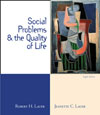CHAPTER 7 Poverty What Is Poverty? (pp. 222-229) In 1998, a family of four would have been officially classified at the poverty
level with an annual income of $16,660 or less. This definition is based on
a Department of Agriculture formula. In brief, the above figure is three times
the current estimated cost of an economy food plan. In practice, this is somewhat
more complex, with variations for family size, sex and ages of members, place
of residence, and so forth. Many people feel that the official definition of
poverty is based on a barely adequate budget for a barely adequate diet. The
official definition is controversial on numerous grounds, but especially because
it excludes many people who define themselves, and whom most of us would define,
as poor. In 1998, 34.5 million people were classified as poor-representing 12.7 percent
of the population. One third or more Americans will be touched by poverty at
some point in their lives. In terms of rates, minorities have higher rates of
poverty than do whites. The high rate of poverty among children is something
new in American history. There is a core of people who remain in poverty, an
underclass that experiences chronic hunger and malnutrition, unemployment, and
substandard housing. And, there are the homeless. Although the proportion of
Americans who are poor is lower than it was in the past, it seems reasonable
to assume that poverty is more difficult when the proportion gets smaller. There
has been a redistribution of income in this country during the 20th century,
but it has not benefited the poor--the richest Americans continue to control
the bulk of the nation's wealth. Poverty and the Quality of Life (pp. 229-238) What are some of the probabilities associated with the poor compared to the
non-poor? The former as infants are more likely to die. Their children, though
intelligent, are more apt to fail in school or drop out. They are more likely
to become mentally ill, to lose their jobs, and to drop out of the labor force.
It is more probable that the poor will experience hostility and mistrust rather
than neighborliness from those around them and less probable that they will
participate in meaningful groups and associations. They are more likely to suffer
chronic illness yet less apt to have health insurance. In short, poverty diminishes
the quality of a person's life in many ways-including the ultimate deprivation,
the probability of death at a younger age. Contributing Factors (pp. 238-248) The authors assert that poverty continues in America in great part because
of the distribution of power and because those who control the wealth are among
the most powerful politically, economically, and socially. Two structural aspects
particularly detrimental to the poor are our bureaucracy's multiple decision-making
centers and its middle-class composition. These aspects mean that various levels
of organization and government, including middle-class-manned bureaucracies,
operate in terms of vested interests of middle and upper classes. Ironically,
the well-to-do and powerful give to each other, through government actions,
what they say is immoral to give to the poor. Also, the economy operates against
the poor, for they have the jobs with the lowest wages but pay higher prices
for consumer goods. Poverty tends to be perpetuated by such factors and by social
psychological factors such as anti-intellectual attitudes and interaction patterns.
Even so, realistic opportunities would allow such negative features and the
fatalism and resignation of the poor to be overcome. What Is to Be Done? (pp. 248-251) The authors criticize our present system of public welfare and suggest that
a continuing effort should be made to establish a welfare system that works.
Workfare is apparently the policy for the future but there are arguments for
and against such programs. The goal should not be to eliminate all government
payments but to eliminate poverty. |



 2002 McGraw-Hill Higher Education
2002 McGraw-Hill Higher Education